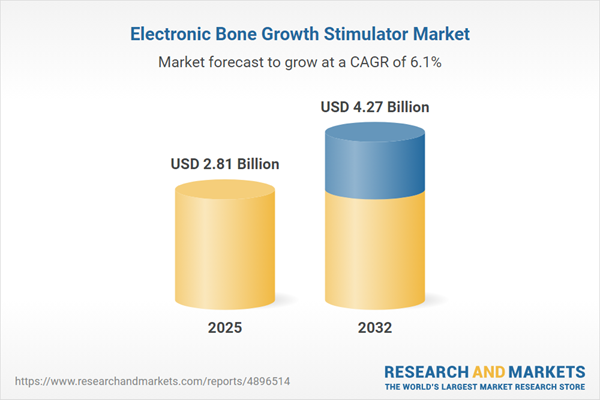Speak directly to the analyst to clarify any post sales queries you may have.
Senior leaders in orthopedics are leveraging the electronic bone growth stimulator market to guide organizational priorities, advance clinical capabilities, and address new care delivery and regulatory demands.
Market Snapshot: Electronic Bone Growth Stimulator Market Size and Growth
The electronic bone growth stimulator market demonstrates notable growth, with projected revenues advancing from USD 2.65 billion in 2024 to USD 2.81 billion in 2025 and anticipated to reach USD 4.27 billion by 2032. A compound annual growth rate of 6.14% underscores the market’s adaptability amid ongoing regulatory shifts and rapid technological innovation. Miniaturization of devices enables broader clinical application, while adoption of value-based healthcare models is prompting orthopedic organizations to diversify treatment options, streamline operations, and enhance outcomes for challenging patient needs. The electronic bone growth stimulator market continues to attract investment from both established industry leaders and new entrants seeking to address evolving care standards.
Scope & Segmentation
This report delivers targeted insights to assist healthcare executives in aligning procurement, technology adoption, and investment planning within the electronic bone growth stimulator sector. Each segment is examined to guide strategic investment decisions and help optimize care pathways in varied orthopedic contexts.
- Product Types: Invasive electrical bone growth stimulators support post-surgical fusion with precise therapy. Low-intensity pulsed ultrasound systems offer noninvasive solutions that improve patient compliance and speed recovery. Noninvasive capacitive and inductive devices provide flexibility in both hospital and outpatient settings. Pulsed electromagnetic field (PEMF) systems accommodate a variety of therapy protocols in orthopedic care.
- Distribution Channels: Direct sales facilitate device integration within clinical workflows, while distributor networks expand institutional reach and access. E-commerce platforms enhance procurement efficiency for outpatient providers and enable rapid deployment for home-based rehabilitation, highlighting the value of digital supply strategies.
- Clinical Applications: Devices are deployed for post-operative recovery, fracture management, and support from spine procedures to multi-joint interventions. Technology-backed treatment ensures continuity across acute and rehabilitative care phases.
- End Users: Ambulatory surgical centers utilize advanced stimulators for efficient patient turnover. Hospitals and clinics address complex orthopedic presentations with dedicated equipment. Home healthcare settings rely on portable, connected devices for real-time monitoring and patient adherence, driving outcomes in decentralized environments.
- Regional Coverage: In the Americas, device uptake is expanding due to favorable reimbursement and supply reliability. EMEA organizations adapt technology rollouts to evolving regulations and compliance. Asia-Pacific entities focus on flexible technology adoption across diverse care environments, maximizing reach and operational agility.
- Key Market Participants: Bioventus Inc., Orthofix Medical Inc., DJO Global Inc., Smith & Nephew plc, Stryker Corporation, Medtronic plc, Kinex Medical Company, IGEA S.p.A., HIGHRIDGE Inc., and Zimmer Biomet offer comprehensive device portfolios to meet the demands of global orthopedic markets.
Key Takeaways for Senior Leaders
- Electronic bone growth stimulators support less invasive orthopedic procedures, helping organizations raise care standards and expand clinical service lines.
- Procurement strategies increasingly focus on selecting rigorously evaluated technology solutions, ensuring organizational resilience and seamless care delivery.
- Telehealth integration provides remote monitoring, enabling specialist oversight and enhancing coordination in distributed care environments.
- Advanced analytics and device interoperability supply critical data, empowering leadership to fine-tune operational strategies and inform long-term planning.
- Flexible procurement practices and adaptive supply chains sustain business continuity despite market or regulatory changes.
- Ongoing collaboration with regulators and industry consortia fosters compliance and positions organizations to navigate emerging standards confidently.
Tariff Impact: Navigating Regulatory and Supply Chain Challenges
Recent tariff adjustments in the U.S. have influenced sourcing and distribution in the electronic bone growth stimulator sector. Manufacturers are forming new alliances with regional suppliers, evaluating nearshoring, and updating logistics frameworks to enhance system resilience. Ongoing communication with regulatory entities remains key to maintaining compliance and successfully operating amid shifting trade policies.
Methodology & Data Sources
Findings are grounded in interviews with orthopedic surgeons, biomedical engineers, and procurement executives. Data were verified through peer-reviewed literature, review of regulatory frameworks, patent landscape analyses, and authoritative industry sources to deliver actionable, trusted recommendations.
Why This Report Matters
- Enables healthcare leaders to strategically invest, benchmark available bone stimulation solutions, and align device inventories with evolving orthopedic requirements.
- Supports procurement and business planning by presenting strategies that drive adoption of advanced technologies within regulatory and operational guidelines.
- Lays the groundwork for strong supply chain management within the fast-changing medical device sector, sustaining risk mitigation and business continuity.
Conclusion
This report equips executive teams to accelerate clinical innovation and streamline operations, improving care efficiency and organizational performance across dynamic orthopedic markets.
Additional Product Information:
- Purchase of this report includes 1 year online access with quarterly updates.
- This report can be updated on request. Please contact our Customer Experience team using the Ask a Question widget on our website.
Table of Contents
3. Executive Summary
4. Market Overview
7. Cumulative Impact of Artificial Intelligence 2025
Companies Mentioned
The companies profiled in this Electronic Bone Growth Stimulator market report include:- Bioventus Inc.
- Orthofix Medical Inc.
- DJO Global Inc.
- Smith & Nephew PLC
- Stryker Corporation
- Medtronic PLC
- Kinex Medical Company
- IGEA S.p.A.
- HIGHRIDGE Inc.
- Zimmer Biomet
Table Information
| Report Attribute | Details |
|---|---|
| No. of Pages | 195 |
| Published | November 2025 |
| Forecast Period | 2025 - 2032 |
| Estimated Market Value ( USD | $ 2.81 Billion |
| Forecasted Market Value ( USD | $ 4.27 Billion |
| Compound Annual Growth Rate | 6.1% |
| Regions Covered | Global |
| No. of Companies Mentioned | 11 |









